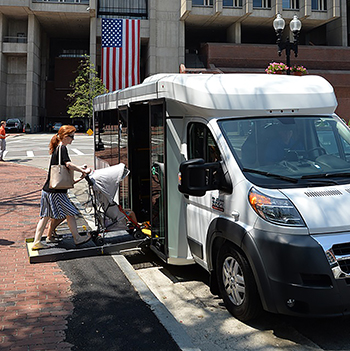
Born from the vision that transportation in the cutaway sized class should be better in every way, the Low Floor Frontrunner is an exposition of the new standard for fuel economy, convenience, safety, durability and passenger comfort that Frontrunner Bus has worked toward since 1988.
With a score of 91 percent at the Altoona Pass/Fail test and more than double the fuel economy of a similarly sized bus with a large V8 engine, the Frontrunner seeks to offer a greener alternative, without the current challenges electric presents.
It’s composite bus structure incorporates patented high density closed cell foam panels with integrated pultrusions for additional strength along the sidewall and door frame. Utilized for outdoor structural projects such as bridge building, pultruded beams are significantly lower in weight than square stocks steel and much stronger.
 “This patented and unique approach to bus body structure provides the highest strength to weight ratio available in the industry today,” said Paul LaRose, president & CEO of Frontrunner Bus. “The entire structure including the front bulkhead panel, sidewalls, roof, and aluminum roof extrusions are bonded with the latest in structural high strength adhesives, achieving a structure whose overall strength is much greater than the strength of its individual parts.”
“This patented and unique approach to bus body structure provides the highest strength to weight ratio available in the industry today,” said Paul LaRose, president & CEO of Frontrunner Bus. “The entire structure including the front bulkhead panel, sidewalls, roof, and aluminum roof extrusions are bonded with the latest in structural high strength adhesives, achieving a structure whose overall strength is much greater than the strength of its individual parts.”
Integrated rain gutters in the roof extrusions designed to channel water to the rear of the bus eliminates the need for unsightly drip moldings over the windows. With almost 1,000 Frontrunners already in service, the Low Floor Frontrunner is looking to represent the next generation in low floor bus technology, design, and manufacturing.
“Without question, the Frontrunner is the most technologically advanced purpose-built low floor mini-bus available today,” LaRose said.
According to LaRose, for those manufacturers satisfied with decades old designs characterized by a lack of durability, poor ride quality, premature corrosion, and very low fuel efficiency of a typical cutaway, the incentive to fix something not perceived to be broken was just not there. These char-acterize the “Would Not” class of manufacturers. Others simply “Could Not” think far enough outside of the box to tackle the challenge of building on a chassis with a 9,350 GVWR and adhere to the additional safety require¬ments associated with sub-10,000 GVWR vehicles. While this presented a significant challenge to Frontrunner Bus Group’s vision for the Frontrunner, it drove its innovative thinking and approach in its design and engineering.
“The result, a proven fuel efficient, lightweight, strong, and durable disrupt¬er to the status quo in achieving a 15-passenger true low floor minibus that makes passenger and drivers happy,” said LaRose.
